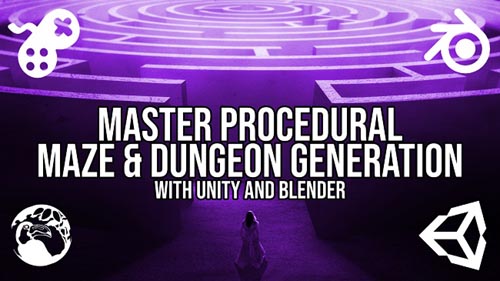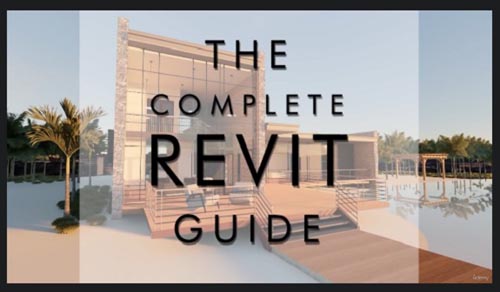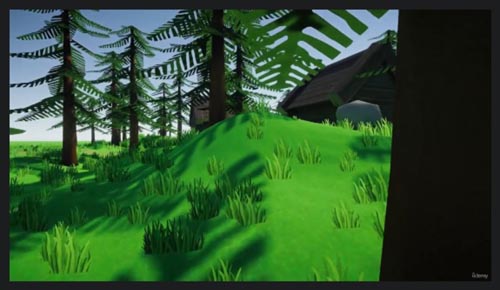Udemy - Master Procedural Maze & Dungeon Generation
Posted on May-27-2022 10:42 | by BNNGUYEN

Udemy - Master Procedural Maze & Dungeon Generation

Udemy - Master Procedural Maze & Dungeon Generation
Duration 20h 30m Project Files Included MP4
Info:
What you'll learn
How to create modular models in blender that can snap together in Unity to form mazes and dungeons.
A variety of maze creation algorithms from simple random crawlers to mathematically perfect mazes.
How the scale, orientation and position of a mesh from Blender can be imported into Unity and manipulated with code.
Requirements
Students should have a basic understanding of Blender and Unity.
Students should be have a working knowledge of C#.
Description
Procedural generation in game development lends itself to the algorithmic generation of unique computer-created environments and gameplay experiences. The power is in its ability to automatically develop game content on the fly, reducing the amount of work required by the game designer. However, a lot of preparation by the programmers and artists is necessary for such a strategy to be implemented. A thorough understanding of the role that both sides of the game development coin (of technical/logic and art/design) play in procedural generation is key for a successful implementation. In this course, Penny and Mike bring a unique experience to both programmers and artists alike and combine their skills and many years of industry and academic knowledge, to bring you a holistic learning experience in which you will find content and invaluable mastery.
This course uses Unity 2020.1 and Blender 2.9 and is Windows and Mac compatible.
Mike will start by teaching you how to model six separate modular meshes that can be put together perfectly to generate an entire maze. He will take you from there into building pieces for a dungeon, where each module is created with a smaller subset of models that can be mixed and matched to speed up your design workflow and production of game assets. You'll create a set of sewer pieces with pipework that snaps together to build a maze and later create the brickwork-textured elements to define a dungeon. Each model will be readied for use in Unity once completed.
Penny will lead you through numerous exercises in the Unity game engine that examine the logic that will snap modular model pieces together using the magic of geometry and mathematics to form an infinite array of maze and dungeon possibilities, worthy of any avid 3D game player. She will take the pieces you create with Mike in Blender and work through a variety of maze generation algorithms to show you the possibilities, from very random environments to perfect mazes that traverse an entire map. She will also work with you to create dungeons with a variety of rooms and interconnecting corridors before exploring multilevel maps, using the A* algorithm for pathfinding and selecting traversable subsets of a complete maze or dungeon.
By the end of this course, you will have a multidisciplinary toolkit of skills that will give you the advantage over others who are "just programmers" or "just artists". Understanding game development that tightly integrates both design and logic from this standpoint is critical to making you a valuable commodity in the job market or preparing you for running an indie operation.
DOWNLOAD HERE :
https://rapidgator.net/file/0bc60b047e912ad099646dfd3eb63fd6/UdemyMasterProceduralMazeDungeonGeneration.part1.rar.html
https://rapidgator.net/file/44057346f893a4df7337b47336967340/UdemyMasterProceduralMazeDungeonGeneration.part2.rar.html
https://rapidgator.net/file/3b06584f9192c006beba78df65a63ec6/UdemyMasterProceduralMazeDungeonGeneration.part3.rar.html
https://rapidgator.net/file/a7406a171929419814decf5cd189dc13/UdemyMasterProceduralMazeDungeonGeneration.part4.rar.html
https://rapidgator.net/file/292904908c6f0c6b1c88a075beb7ed8b/UdemyMasterProceduralMazeDungeonGeneration.part5.rar.html
https://rapidgator.net/file/29944d6f49b4bd3677bddc4fe60ae73e/UdemyMasterProceduralMazeDungeonGeneration.part6.rar.html
https://rapidgator.net/file/89f92cc2c7d93c174d41507545aef31c/UdemyMasterProceduralMazeDungeonGeneration.part7.rar.html
https://rapidgator.net/file/d783e2aca92494ae8d26d476939040c4/UdemyMasterProceduralMazeDungeonGeneration.part8.rar.html
ADD COMMENT
 Udemy - Complete Revit Guide - Model a Modern Multistory Building
Udemy - Complete Revit Guide - Model a Modern Multistory Building
 Maxon Cinema 4D R26.013 Win/Mac x64
Maxon Cinema 4D R26.013 Win/Mac x64
 Udemy - Revit Architecture 2022
Udemy - Revit Architecture 2022
 Udemy - Unity Game Asset Creation in Blender: Textured 3D Models
Udemy - Unity Game Asset Creation in Blender: Textured 3D Models